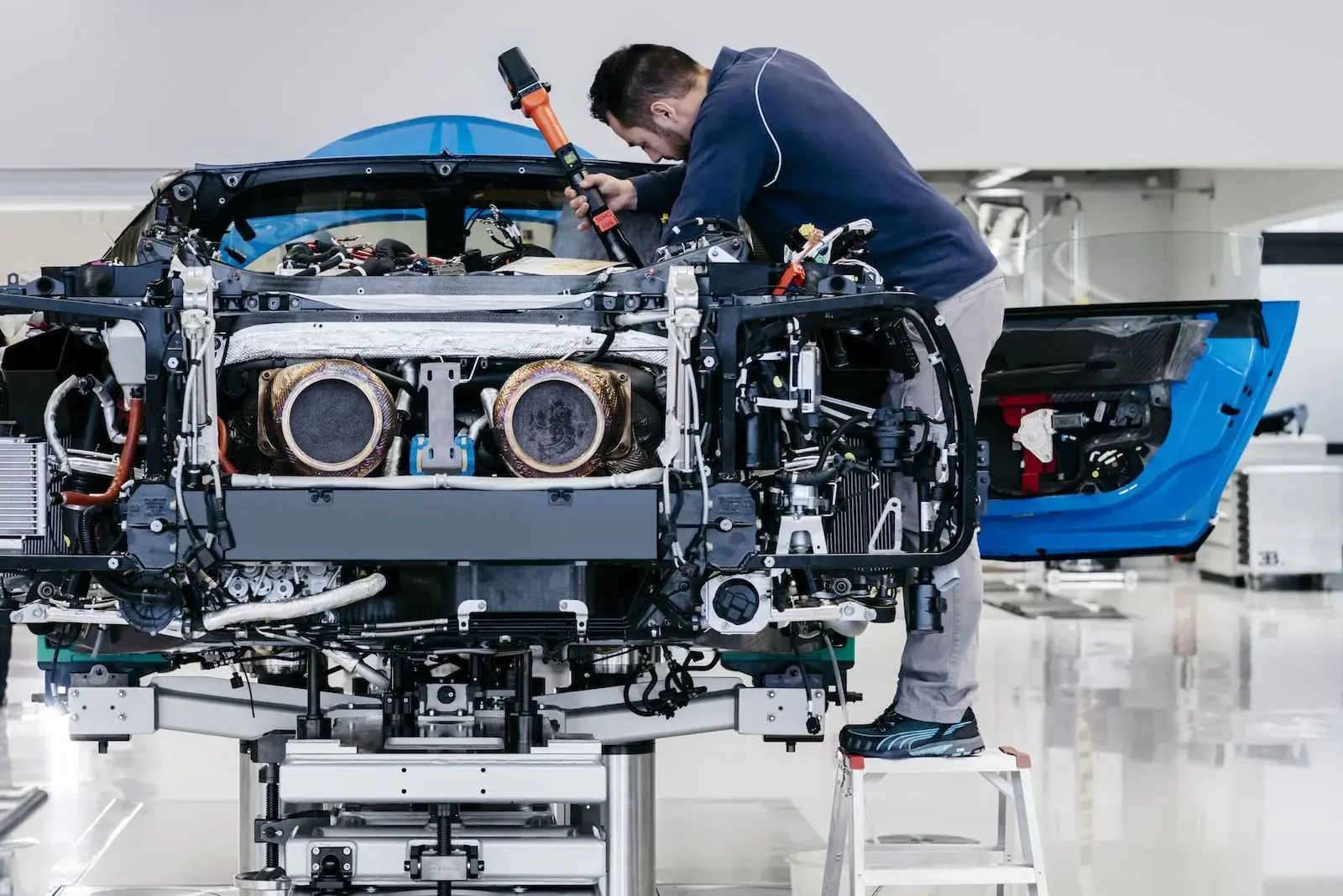The Bugatti Chiron is a hyper sports car that features an ultra-powerful 1500 horsepower engine and can reach top speeds of 420 kilometers an hour. The production process of the car is carefully explained, including the assembly of the rolling chassis by hand and the building of the engine over one week by two technicians. The documentary delves into the history of Bugatti, with founder Ettore Bugatti’s vision to revolutionize the automotive industry. The importance of sound perception in creating a positive driving experience is highlighted, and the documentary shows the complex process of creating the brakes, assembling the monocoque, and filling the car with operating fluids before it undergoes rigorous testing before delivery.
- (00:00:00) In this section, the Bugatti Chiron hyper sports car is introduced as the fastest, most extreme, and exclusive production super sports car that scratches the boundaries of physics, with an ultra-powerful 1500 horsepower engine and a top speed of 420 kilometers an hour. The production process of the Chiron prototype is explained, and how Bugatti is part of the Haut-Koenigsbourg manufacturers. The documentary shows the Dream Factory, where some 300 people work to develop, build, and sell these super sports cars, and the process of assembling around 2600 individual parts to form one car. The Chiron’s rolling chassis is assembled strictly by hand, a drivable naked vehicle skeleton that the employees marry with one another during production.
- (00:05:00) In this section, we learn that the Bugatti Chiron is made entirely of carbon fiber reinforced plastic and the car is capable of topping 400 kilometers per hour and can accelerate from zero to 100 in less than three seconds. The wiring harness inside the carbon cockpit is the nerve system of the Chiron as it connects the vehicles 20 control units. The exclusive kupe’s 640-kilogram 16-cylinder engine, which is considered the holy grail of engines, is built in SATs katha over one week by two technicians. The engine is built to be compact and light with eight cylinders distributed over each of the two v-shaped banks, creating an artificial W engine with 16 cylinders. The W 16 achieves its maximum acceleration with four high-performance turbochargers via turbine, compressing the air in taken at the front of the vehicle and pressing it into the combustion chamber in stages.
- (00:10:00) In this section, we learn about the assembly of the Sheeran engine, which is made up of around 3,700 individual parts, by skilled technicians at workplaces next to the assembly stand. The engine draws its power from the ignition of a fuel air mixture facilitated by sixteen spark plugs. The engine blocks have been made by hand at Bugatti since the company’s inception in 1909. Although working conditions were tougher, the basic structure of high-performance engines has barely changed. The massive powerplant is considerably bigger, with a four-fold increase in dimensions compared to a standard passenger car engine.
- (00:15:00) In this section, we learn about the history of Bugatti and how the company’s founder, Ettore Bugatti, was a perfectionist who aimed to revolutionize the automotive industry. The Bugatti name gained recognition through record-breaking race victories of the Bugatti super sports cars in the 1920s. Fast forward to present day, we see how the Bugatti Chiron is pushing the boundaries with its 8-liter engine and 16 cylinders that can produce up to 1600 horsepower. To ensure the durability of each power plant, engineers have developed their test bench and torture engines for up to 1000 hours. Furthermore, acoustic factors are crucial to the driving experience of the Chiron, with the sound of the engine being an entirely unconscious process, making it important to verify any sound simulations during an auditory test.
- (00:20:00) In this section, the importance of sound and noise perception in creating a positive driving experience is highlighted. Bugatti’s test driver, former Le Mans winner Andy Wallace, plays a crucial role in providing feedback to developers about the Chiron’s performance and handling from the driver’s cockpit. Wallace will also set a new speed record of 304.773 miles per hour in the pre-production model of the Chiron’s Super Sport 300+. The assembly process of the vehicle is demonstrated, including the coupling of the seven-speed transmission to the engine block and the building of the rear section of the vehicle around the high-performance unit. The highly polished synthetic resin floor of the assembly shop, covering 1,000 square meters, showcases the precision and attention to detail of the Bugatti factory workers.
- (00:25:00) In this section, we learn about the unique independent wheel suspension of the Bugatti Chiron, which allows each wheel to be actuated individually for maximum grip and stability even on wet roads. The suspension system is adaptive and can be set to a family car or racing car profile, with the damper hardness adjusted depending on the driving situation. The production process for the Chiron is complex, involving 2590 steps and a team of 20 people who assemble the vehicle in eight weeks. The Chiron’s exhaust system, including its enormous titanium muffler, is also designed to withstand extreme heats. The differential compensates for differences in wheel speeds when cornering, while the brake system is built to withstand temperatures of up to 1,100 degrees during braking at its top speed of 420 km/h.
- (00:30:00) In this section, the documentary takes us through the process of creating the brakes for the Bugatti Chiron, which currently has the most powerful brakes of any production vehicle worldwide. The designers discuss a potential new brake saddle model that they are testing which would allow them to save weight while maintaining the required strength, and the enormous carbon ceramic brake discs are fitted on the wheel suspension. The process of assembling the front of the monocoque is shown, along with the rear section being joined to it using fourteen titanium bolts. Finally, the Bugatti mechanics fasten the lines for the car’s operating fluids, and the Sheerin’s custom Michelin tires are discussed, which need to withstand enormous forces during vehicle operation at maximum speed.
- (00:35:00) In this section, the Bugatti Chiron is filled with its operating fluids including engine oil, brake fluid, and 40 liters of water that circulates 20 times per minute to prevent overheating. The hypercar’s fuel tank can hold 100 litres of gasoline and consumes an average of 22.5 litres every 100 kilometers. The Chiron then proceeds to undergo 342 tests on the Bugatti dynamometer, the most powerful of its kind in the world. On completing all tests, it is dressed in its Sunday best which takes up to four days to complete, and can be completely personalized according to the customer’s wishes.
- (00:40:00) In this section, the video discusses how the design of the Bugatti Chiron is not just for aesthetics but also serves specific technical purposes. The unique shape of the Exclusive Koopas extraordinary radiator grille, nicknamed the horseshoe, was adapted to improve the car’s aerodynamics and cool the increasingly larger engine. Additionally, the Chiron’s paneling consists of both active and passive systems that aid in aerodynamics and cooling, which played a significant role in Juan Pablo Montoya’s world record when he brought the car from a standing start to 400 kilometers an hour in just 41.96 seconds. The video concludes by showing another Chiron being assembled and covered with protective coatings to prevent scratches on its first test drive.
- (00:45:00) In this section, we learn about the rigorous test drive procedure that a Bugatti Chiron undergoes before it is delivered to the customer. The car has to complete a test drive of 350 kilometers and is driven on different kinds of roads before it is taken to an airfield to test the car’s capabilities. A key is used to unlock the car’s full potential speed-wise but is only used when all systems are checked automatically. The Chiron is then taken to a washing facility and can only be delivered to its new owner once it is spotless.









